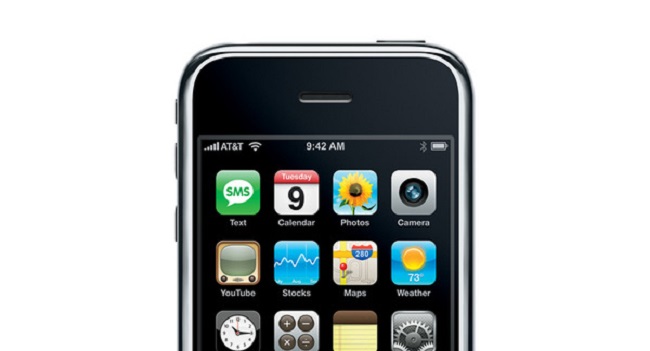Artificial Intelligence is no longer a distant promise or a Silicon Valley experiment. It’s embedded in the now. South Africans are already using generative…
The iPhone 1: Apple’s sour start


When the first iPhone launched in 2007, most of us who remember owning one can attest to its (at the time) revolutionary features. It was a touchscreen phone that worked well, looked great and did stuff others phones couldn’t at the time. In 2014, we have choice now, a choice largely broadened by the iPhone 1. It had issues though, ones that Bob Borchers, its former senior director of product marketing even going as far as to call it “okay” and “not a great phone”. Oddly enough, he’s correct. The beauty of the iPhone 1 only went skin-deep, and numerous issues plagued it. These issues didn’t stop it from changing the smartphone landscape, it’s just nice to know what’s in the past now.
What it initially did wrong:
The camera sparked the intuitive era of smartphone photography, but there were basic issues like a lack of auto focus or video recording. On the LG G2, swapping to video recording and image capturing is now tied to a software toggle as are most mobile phone recording apps. It would be hard to imagine a phone with no video capture, even the cheapest Androids have these. The first iPhone which could capture video was the 3GS, and the 3G as well, if it was jailbroken.
Custom ringtones couldn’t be loaded on the iPhone 1, at least not for the first four months post-launch. Apple hastily cobbled together a software update and 5 September 2007, users could now purchase songs off iTunes to be used as ringtones. This is still the default method for loading custom ringtones and seven years on, Apple still hasn’t fixed this annoyance which Android users never experience — the OS allows users to drag and drop music inside a ringtone folder without any security issues.
It was the internet experience which Apple kind of broke with the iPhone 1. Borchers said that the first iPhone was meant to be “the best iPod in your pocket” with the internet only featuring second in importance. It’s the hindsight that makes us realise how correct he is. I owned the first iPhone and was puzzled by the great looking browser — Safari — which loaded fairly slowly.
It was because iPhone 1 was 2G only, we’d have to wait for the 3G to get respectable speeds. Almost every phone in 2007 was switched over to 3G, but Apple didn’t see the need. It said that its iPhone may give a slower-than-3G EDGE connection (to conserve power), but you’ll get faster than 3G when connected to the WiFi.
What? It’s like Toyota telling me that my car will drive slower, use less power, but drive really fast when I’m inside the parking lot. Apple obviously changed that when it realised the iPhone’s potential to be a mobile social networking circus.
When the speeds were all WiFi and nippy, Safari held us back. To this day, the browser refuses to crack the nod to sites with Java or Flash. Since every website in 2007 was using Flash and Java to astound us, Safari kind of left us crippled. While I still prefer Chrome browser on an Android phone, Safari looked slicker even in 2007, thanks to the nicely rendered browser window. But, sites loaded slowly and the most popular ones wouldn’t load at all. Apple changed all that, by making the internet its bitch. Yes, Apple’s structured the technology which makes up the internet itself, by championing HTML 5 as the new “new” Flash and making it replace streaming technology it won’t place nice with. Today, YouTube is the last great reminder of Flash, which is far less popular than it was. Maybe this was Apple’s plan, to test the waters before it’s attempt to reshape the internet.
iOS was an incredibly plain affair, with Apple saying that iPhone OS (it was only named iOS in 2010) was modelled after OSX and nothing more. These were all the features of the first iPhone:
- Text messaging
- Google Maps
- Notes
- Photos
- Calendar
- Camera
- Calculator
- Safari
- Phone
- iPod Player
- Clock
- YouTube
- Stock
- Weather
No third-party applications, and no way to open up the most-used email attachment at the time, Office files. That all changed in 2008 with the release of iOS 2, which added push-email, the App Store, and the ability to view YouTube files in the web browser, as mother nature intended it to be. Hundreds of updates have turned iOS 7 into an almost intuitive interface, I think.
Those of us who remember the first iPhone can attest to the fact that there was no copy and paste. Yes, try to imagine not being able to cut and copy text into your phone today. It would seem like water torture, because you’d dunk the iPhone 1 into a bath. It was also impossible to text multiple contacts at once, and power Gmail users were left in the dark as there were no native POP email options. Android went ahead and integrated our Gmail and Google details into the core of its OS, with Apple fixing this small error a year after the release of the iPhone 1.
I’d be fooling myself if I scoffed at the iPhone 1 (or the iPhone 2G) when I first got my hands on it. It was genuinely the most beautiful phone I’d ever seen, and the thing just looked so black. Like a hunk of rare rock with icons. So while Apple’s former employees can look back and poke holes, it would be impossible for the 2007 version of you to resist the iPhone 1. We can all be glad that Apple fixed the major software issues only a year into the product’s life-cycle because the version we have today is the best iPhone, just not the best smartphone there is. It’s also good to look back and consider what Apple originally made, in light of how slick the iPhone 6 will hopefully be.
None of this means that iOS isn’t still (ironically) in the shadow of Android, an OS with endless customisation options and an app selection to rival Apple’s. Comparing the phones on both sides are debatable and ultimately meaningless though, as most of us who purchase iPhones are either in it for life or turned off by Android, simple enough. What the iPhone 1 delivered was competition, and that in turn helped to shape the current iPhone and it’s peers.


